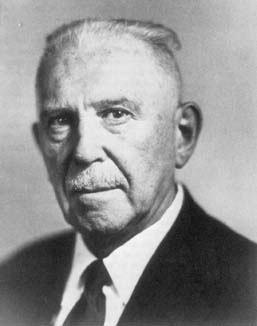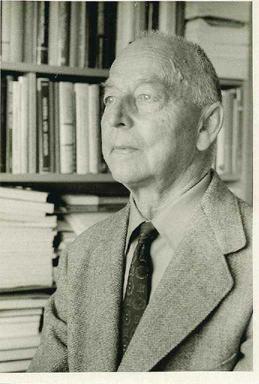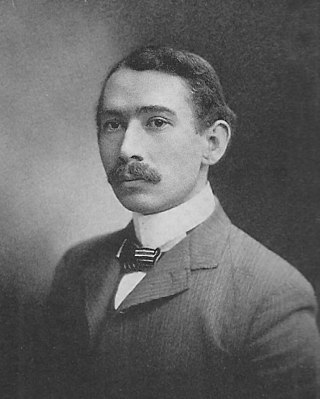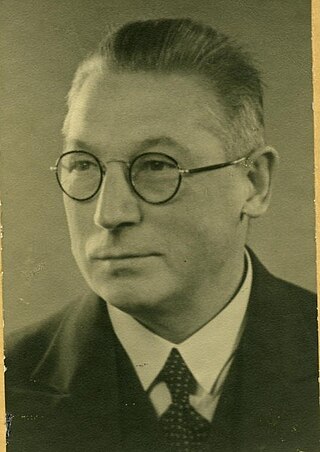Related Research Articles

Harold Scott MacDonald "Donald" Coxeter was a British-Canadian geometer and mathematician. He is regarded as one of the greatest geometers of the 20th century.

Solomon Lefschetz was a Russian-born American mathematician who did fundamental work on algebraic topology, its applications to algebraic geometry, and the theory of non-linear ordinary differential equations.

Frank Morley was a leading mathematician, known mostly for his teaching and research in the fields of algebra and geometry. Among his mathematical accomplishments was the discovery and proof of the celebrated Morley's trisector theorem in elementary plane geometry. He led 50 Ph.D.'s to their degrees, and was said to be:

Ernest William Hobson FRS was an English mathematician, now remembered mostly for his books, some of which broke new ground in their coverage in English of topics from mathematical analysis. He was Sadleirian Professor of Pure Mathematics at the University of Cambridge from 1910 to 1931.

Luther Pfahler Eisenhart was an American mathematician, best known today for his contributions to semi-Riemannian geometry.

Andrew Russell Forsyth, FRS, FRSE was a British mathematician.
Robert Steinberg was a mathematician at the University of California, Los Angeles.
Johan Frederik Steffensen was a Danish mathematician, statistician, and actuary who did research in the fields of calculus of finite differences and interpolation. He was professor of actuarial science at the University of Copenhagen from 1923 to 1943. Steffensen's inequality and Steffensen's method are named after him. He was an Invited Speaker at the 1912 International Congress of Mathematicians (ICM) in Cambridge, England and at the 1924 ICM in Toronto.
... His more important works included the theory of statistics (1923), interpolation (1925), insurance mathematics (1934) and the calculation of interest (1936). ... He was President of the Danish Actuarial Society in 1922-24 and 1930-33, and of the Danish Mathematical Society in 1930-36 ...

Joseph Leonard Walsh was an American mathematician who worked mainly in the field of analysis. The Walsh function and the Walsh–Hadamard code are named after him. The Grace–Walsh–Szegő coincidence theorem is important in the study of the location of the zeros of multivariate polynomials.
Cecil James Nesbitt, Ph.D., F.S.A., M.A.A.A. was a mathematician who was a Ph.D. student of Richard Brauer and wrote many influential papers in the early history of modular representation theory. He taught actuarial mathematics at the University of Michigan from 1938 to 1980. Nesbitt was born in Ontario, Canada. He received his mathematical education at the University of Toronto and the Institute for Advanced Study in Princeton. He served the Society of Actuaries from 1985 to 1987 as Vice-President for Research and Studies. He developed the Schuette–Nesbitt formula with Donald R. Schuette.

Arthur Byron Coble was an American mathematician. He did research on finite geometries and the group theory related to them, Cremona transformations associated with the Galois theory of equations, and the relations between hyperelliptic theta functions, irrational binary invariants, the Weddle surface and the Kummer surface. He was President of the American Mathematical Society from 1933 to 1934.

Sigurdur Helgason is an Icelandic mathematician whose research has been devoted to the geometry and analysis on symmetric spaces. In particular, he has used new integral geometric methods to establish fundamental existence theorems for differential equations on symmetric spaces as well as some new results on the representations of their isometry groups. He also introduced a Fourier transform on these spaces and proved the principal theorems for this transform, the inversion formula, the Plancherel theorem and the analog of the Paley–Wiener theorem.
John Wesley Young was an American mathematician who, with Oswald Veblen, introduced the axioms of projective geometry, coauthored a 2-volume work on them, and proved the Veblen–Young theorem. He was a proponent of Euclidean geometry and held it to be substantially "more convenient to employ" than non-Euclidean geometry. His lectures on algebra and geometry were compiled in 1911 and released as Lectures on Fundamental Concepts of Algebra and Geometry.
Louis Weisner was an American-Canadian mathematician at the University of New Brunswick who introduced Weisner's method.
Gordon Thomas Whyburn was an American mathematician who worked on topology.
Henry Lewis Rietz was an American mathematician, actuarial scientist, and statistician, who was a leader in the development of statistical theory. He became the first president of the Institute of Mathematical Statistics.

James Waterman Glover was an American mathematician, statistician, and actuary.
Robert McDowell Thrall (1914–2006) was an American mathematician and a pioneer of operations research.
Roger David Nussbaum is an American mathematician, specializing in nonlinear functional analysis and differential equations.

Rudolf Ernst Rothe was a German applied mathematician.
References
- 1 2 Murphy, R. D.; Richardson, R. G. D. (1942). "Robert Henderson – In Memoriam". Bulletin of the American Mathematical Society. 48 (7): 504–505. doi: 10.1090/S0002-9904-1942-07695-6 .
- ↑ Nesbitt, Cecil J. (1989). "Personal reflections on actuarial science in North America from 1900". A Century of Mathematics in America, Part III. pp. 617–638.
- ↑ "Obituary. Robert Henderson 1871–1942" (PDF). Proceedings of the Casualty Actuarial Society. 28 (58): 631–633. 1942.
- ↑ Henderson, Robert (1925). "Life insurance as a social science and as a mathematical problem". Bulletin of the American Mathematical Society. 31: 227–252. doi: 10.1090/S0002-9904-1925-04040-9 . (text of the 1924 Gibbs Lecture)
- ↑ "Members of the Society". Bulletin of the American Mathematical Society. 17: 11–65. 1911. doi: 10.1090/S0002-9904-1911-01974-7 . (See p. 33.)
- ↑ "APS Member History". search.amphilsoc.org. Retrieved 2023-08-02.
- ↑ "American Mathematical Society Trustee" (PDF). 8 March 2016: 6.
{{cite journal}}: Cite journal requires|journal=(help) - 1 2 "Endowment fund and Special funds". Bulletin of the American Mathematical Society. 48 (9): 5–6. 1942. doi: 10.1090/S0002-9904-1942-07759-7 .
- ↑ Hollcroft, T. R. (1942). "The Summer meeting in Poughkeepsie". Bulletin of the American Mathematical Society. 48 (11): 800–809. doi: 10.1090/S0002-9904-1942-07791-3 . (See p. 804.)
- ↑ "Endowment Fund". Bulletin of the American Mathematical Society. 52 (11): 5. 1946. doi: 10.1090/S0002-9904-1946-08698-X .
- ↑ "Notices of the AMS". November 1995: 1323.
{{cite journal}}: Cite journal requires|journal=(help) - ↑ "Reviewed Work: Mathematical Theory of Graduation by Robert Henderson". Journal of the Institute of Actuaries (1886-1994). 70 (2): 264–266. July 1939. doi:10.1017/s002026810001177x. JSTOR 41138651.